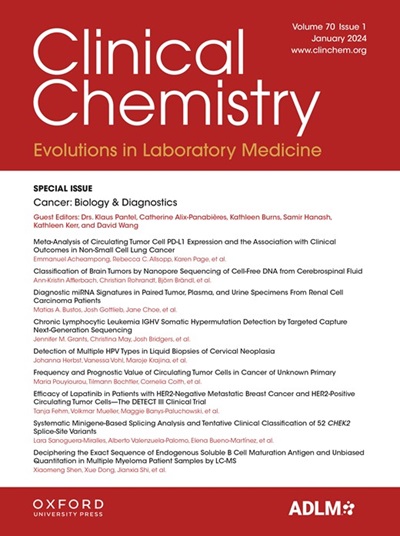B-014 Performance evaluation of the automated cell image analyzer DI-60 for leukocyte differential count
IF 7.1
2区 医学
Q1 MEDICAL LABORATORY TECHNOLOGY
引用次数: 0
Abstract
Background The Sysmex DI-60 system (Sysmex, kobe, Japan) is an automated cell image analyzer that captures cell images and analyzes them. The aim of this study was to evaluate the performance of DI-60 for leukocyte differential count in comparison with manual differential count or XN-20. Methods A total of 205 samples were analyzed. The agreement between DI-60 pre-classification and post-verification by medical technicians was determined. The correlation and ability to identify clinically important abnormal cells of DI-60 post-verification were evaluated. Results The overall agreement of DI-60 pre-classification was 84.7% (Table 1). The correlation between DI-60 post-verification and manual differential counts were exellent (r2 > 0.85) for neutrophil, lymphocyte, monocyte and eosinophil, but was very low for basophil (r2 = 0.3759). The correlation between DI-60 post-verification and leukocyte differential counts by XN-20 were exellent (r2 > 0.90) for neutrophil, lymphocyte and eosinophil. However, monocyte and basophil showed a relatively low correlation of r2 = 0.6343 and r2 = 0.3118, respectively but was very low for basophil (r2 0.3759). The ability of DI-60 post-verification to identify clinically important abnormal cells including blast, promyelocyte, myelocyte, metamyelocyte and NRBC demonstrated excellent efficiency (80.8 to 96.3%) except for NRBC (51.0%). Overall sensitivity was 63.7-88.2%, and specificity was 84.3-95.5% excluding NRBC (43.7%). Conclusions DI-60 showed excellent pre-classification and generally high correlation compared to manual leukocyte differential counts. Although additional verification with PBS review by experienced medical technician may still be required, the performance DI-60 makes it an efficient screening tool in clinical laboratories.B-014 用于白细胞差异计数的 DI-60 自动细胞图像分析仪的性能评估
背景 Sysmex DI-60 系统(Sysmex,日本神户)是一种自动细胞图像分析仪,可捕捉细胞图像并进行分析。本研究的目的是评估 DI-60 与人工差分计数或 XN-20 相比在白细胞差分计数方面的性能。方法 共分析了 205 个样本。确定了 DI-60 预分类与医疗技术人员后验证之间的一致性。评估了 DI-60 后验证的相关性和识别临床重要异常细胞的能力。结果 DI-60 预分类的总体一致性为 84.7%(表 1)。在中性粒细胞、淋巴细胞、单核细胞和嗜酸性粒细胞方面,DI-60 验证后计数与人工鉴别计数之间的相关性极佳(r2 >0.85),但在嗜碱性粒细胞方面相关性很低(r2 = 0.3759)。对于中性粒细胞、淋巴细胞和嗜酸性粒细胞,DI-60 后验证与 XN-20 的白细胞差异计数之间的相关性非常好(r2 >0.90)。然而,单核细胞和嗜碱性粒细胞的相关性相对较低,分别为 r2 = 0.6343 和 r2 = 0.3118,但嗜碱性粒细胞的相关性非常低(r2 0.3759)。除 NRBC(51.0%)外,DI-60 后验证识别临床上重要的异常细胞(包括胚泡、原核细胞、骨髓细胞、偏骨髓细胞和 NRBC)的能力显示出卓越的效率(80.8%-96.3%)。总体灵敏度为 63.7%-88.2%,特异性为 84.3%-95.5%,NRBC(43.7%)除外。结论 DI-60 与人工白细胞差值计数相比,显示出卓越的预分类能力和普遍较高的相关性。尽管可能仍需要由经验丰富的医疗技术人员通过 PBS 复核进行额外验证,但 DI-60 的性能使其成为临床实验室的一种有效筛查工具。
本文章由计算机程序翻译,如有差异,请以英文原文为准。
求助全文
约1分钟内获得全文
求助全文
来源期刊

Clinical chemistry
医学-医学实验技术
CiteScore
11.30
自引率
4.30%
发文量
212
审稿时长
1.7 months
期刊介绍:
Clinical Chemistry is a peer-reviewed scientific journal that is the premier publication for the science and practice of clinical laboratory medicine. It was established in 1955 and is associated with the Association for Diagnostics & Laboratory Medicine (ADLM).
The journal focuses on laboratory diagnosis and management of patients, and has expanded to include other clinical laboratory disciplines such as genomics, hematology, microbiology, and toxicology. It also publishes articles relevant to clinical specialties including cardiology, endocrinology, gastroenterology, genetics, immunology, infectious diseases, maternal-fetal medicine, neurology, nutrition, oncology, and pediatrics.
In addition to original research, editorials, and reviews, Clinical Chemistry features recurring sections such as clinical case studies, perspectives, podcasts, and Q&A articles. It has the highest impact factor among journals of clinical chemistry, laboratory medicine, pathology, analytical chemistry, transfusion medicine, and clinical microbiology.
The journal is indexed in databases such as MEDLINE and Web of Science.
 求助内容:
求助内容: 应助结果提醒方式:
应助结果提醒方式:


